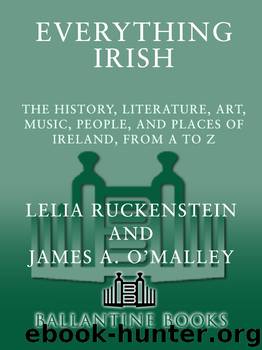Everything Irish by Lelia Ruckenstein

Author:Lelia Ruckenstein [Ruckenstein, Lelia]
Language: eng
Format: epub
ISBN: 978-0-307-48445-1
Publisher: Random House Publishing Group
Published: 2013-11-19T16:00:00+00:00
L
Labour Party, the. Political party. The Labour Party was formed in 1912, but had only a minimal organizational existence before the foundation of the Irish Free State. Since 1922, Labour has seen itself as the political party of the trade union movement. In practice, however, the Labour Party had a difficult relationship with the trade unions. Though part of the European social democratic tradition, Labour has had a low level of support. Its inability to form a government on its own has reduced Labour’s position in Ireland to that of a minority party and Labour has had to make many compromises as part of coalition governments with much larger conservative parties. Its leaders have been: Thomas Johnson (1918–27), T. J. O’Connell (1927–32), William Norton (1932–60), Brendan Corish (1960–77), Frank Cluskey (1977–81), Michael O’Leary (1981–82), Dick Spring (1982–97), Ruairi Quinn (1997–2002), and Pat Rabbitte (2002 to present).
In the first election with (near) universal suffrage, in 1918, Labour stood aside to give Sinn Féin a free run to highlight popular support for independence. This decision certainly weakened Labour in a crucial period of its development. Serving as the opposition while anti-treaty Sinn Féin boycotted the new Parliament from 1922 to 1926, Labour aligned itself with Fianna Fáil in the 1932 general election, identifying with that party’s more Republican stance and its policy to end payment of land annuities to Britain. Splits and personality clashes in the trade union movement often spilled over into the Labour Party, and the party itself actually split in 1943. Labour remained a largely conservative force during this period; its position to the “left” of Irish politics was modified by its large rural vote and the conservative policies of the trade union leadership.
In the post–World War II period, Labour’s only way of holding political office was to form coalition governments with Fine Gael (and other small parties) in 1948–51 and 1954–57. Labour moved to the left in the late 1960s, reflecting the political mood of the time. Their 1969 election result was, however, very disappointing and though they formed a coalition government with Fine Gael in 1973, it was from a position of relative weakness. The unpopularity of that government and its conservative economic policy in response to the oil crisis led to deep splits in the party. Labour served in government with Fine Gael again from 1981 to February 1982, and November 1982 to 1987. The splits in the party, between radicals and conservatives, were now very bitter and Labour was under severe electoral pressure from the left-wing Workers Party, especially in Dublin and other urban centers. Labour’s relationship with trade unions also reached a low point at this time. The unions criticized Labour’s compromises in government and sought to influence public policy directly, rather than rely on the Labour Party.
A period in opposition allowed Labour to reestablish some credibility. In the general elections of 1992, Labour achieved its highest-ever vote, 19.3 percent—mostly new middle-class supporters who deserted Fine Gael and Fianna Fáil and voters unhappy with the government’s performance.
Download
This site does not store any files on its server. We only index and link to content provided by other sites. Please contact the content providers to delete copyright contents if any and email us, we'll remove relevant links or contents immediately.
Periodization Training for Sports by Tudor Bompa(8170)
The Body: A Guide for Occupants by Bill Bryson(4974)
The MacArthur Bible Commentary by John MacArthur(4749)
The Sports Rules Book by Human Kinetics(4294)
What It Really Takes to Get Into Ivy League and Other Highly Selective Colleges by Hughes Chuck(3696)
Marijuana Grower's Handbook by Ed Rosenthal(3623)
The Sprouting Book by Ann Wigmore(3543)
The Martian by Andy Weir(3309)
Salt, Fat, Acid, Heat: Mastering the Elements of Good Cooking by Nosrat Samin(3108)
The Bread Bible by Rose Levy Beranbaum(3004)
Harry Potter 4 - Harry Potter and The Goblet of Fire by J.K.Rowling(2990)
Sapiens and Homo Deus by Yuval Noah Harari(2987)
The Marketing Plan Handbook: Develop Big-Picture Marketing Plans for Pennies on the Dollar by Robert W. Bly(2975)
Classic by Mary Berry(2942)
Martha Stewart's Baking Handbook by Martha Stewart(2796)
Screenplay: The Foundations of Screenwriting by Syd Field(2574)
The Plant Paradox by Dr. Steven R. Gundry M.D(2547)
50 Economics Classics by Tom Butler-Bowdon(2523)
The Cambridge Grammar Of The English Language by Rodney Huddleston Geoffrey K. Pullum(2383)
